| |

Traditions, folklore, history and more. If it's Irish, it's here. Or will be!
"People will not look forward to posterity who never look backward to their ancestors."
-Edmund Burke




Quotes
Library: Books, Movies, Music
Prints & Photos
Poetry
Jokes


Shops Ireland
Bunús na Gaeilge
(Basic Irish)
Circle of Prayer
Blessings
Did You Know?
Himself/Herself
Write to Us
Readers Write..
Links/Link to Us
Advertise with us
Awards & Testimonials
Submissions Guide


|
|
|
A Visit to St. Patrick’s Well
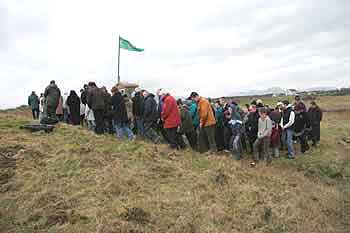 by Joe McGowan by Joe McGowan
Far away from the razamataz and the ballyhoo, the leprechaun hats and the plastic shamrocks of the big city and town parades, there are still some who celebrate the feast of St. Patrick as it has always been done. One such place is a quiet field in Corbeg, roughly half a mile from the Duff River on the Sligo-Leitrim border. This, we are told, was one of the saint's favourite places.
There are two wells there, one called ‘Tobair Phadhraig’ (Patrick’s Well) near the road, and the other ‘Tobair na Bheartha’ (Well of the Shaving) close to the sea. Local tradition has it that St. Patrick and his companions shaved at ‘Tobair na Bheartha’. Does this prove the case that Patrick, being a Roman, actually did shave and did not wear, as is popularly depicted, a long beard?
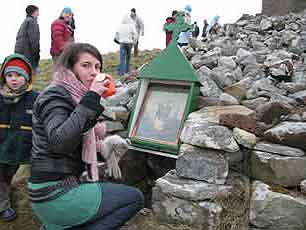 Photo: Italian visitor Maria Rita Salvi takes the healing water while Rían Lueck-McGowan looks on Photo: Italian visitor Maria Rita Salvi takes the healing water while Rían Lueck-McGowan looks on
Cures
Many cures have been performed in this place. An account written in 1938 says that: ‘For a cure for sore eyes the water is rubbed on, for a cure for a sick animal it is given to the beast to drink. Numerous cures have been reported. People have been cured of sore eyes, sore throat, toothaches, headaches and many other ailments. Cattle have been cured of murrain, redwater, milk fever, spine disease. Elf-shot cows have been cured and cows with chill or fever. Horses have been cured by applying the water to the affected part.’ Many years ago my mother sent me to 'Tobair Phadhraig’ for the blessed water to cure a sick cow.
Blessings and Curses
Once, on his way north, the saint passed over the nearby River Duff on the Sligo-Leitrim border. Seeing men fishing there for salmon he asked them if he could have some. ‘They’re scarce today,’ was the reply from the tight-fisted Leitrim men. ‘May they always be so,’ replied the disgruntled holy man. That finished the fishing there for a long time. Leitrim has a very short shoreline, so presently St. Patrick and his followers came to the River Drowes that separates Co. Donegal from Co. Leitrim. The Cassidy family and their helpers were fishing for salmon. Still hungry, Patrick begged them for a fish, which they immediately gave him. Perhaps they had heard about the incident up the road. It doesn't matter, Patrick had his dinner and he was grateful. Blessing the river he said:
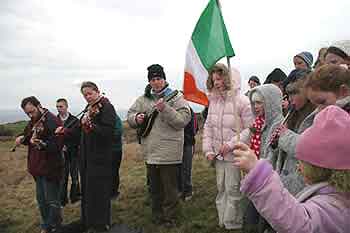 ‘May the Drowes never be without a salmon nor a Cassidy to catch them.’ ‘May the Drowes never be without a salmon nor a Cassidy to catch them.’
‘And,’ says the ‘Tripartite life of St. Patrick’, ‘even little boys take fish there still, and a salmon of the Drowes is the finest of Ireland’s salmon.’ To this day the Drowes continues to be a popular fishing spot. It is one of the earliest in Ireland and generally produces the first salmon of the year. The Cassidys, direct descendants of Patrick's benefactors, owned and fished the river up to very recent times.
Photo: Margaret Rhattigan and friends provide the music
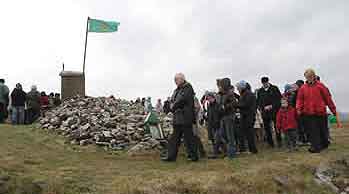 Doing The Rounds Doing The Rounds
I join a steady trickle of people and we walk down the narrow road and across a green pasture-field. Very little has changed here since the time of Patrick himself. As we walk we look across magnificent views of the Sligo mountains on our left, and a majestic panorama of ocean, hill and sky, right around to Sliabh League in Co. Donegal, on our right. We draw near to ‘Tobair Phadhraig’ and the strains of Irish music comes to our ears. Despite the cold, a small group of musicians, fiddle, tin whistles, mandolin, play a selection of Irish airs. Before emigration stripped the countryside of young people, large crowds followed the Seamus Devins’ Pipe Band from Grange and Bunduff Fife and Drum Band who used to come here.
 Father Keogan leads his flock Father Keogan leads his flock
The parish priest of Kinlough, Fr. Keogan, joins us and after saying a few words on the significance of the well leads the group in prayer. Round and round the well we go. The Schools Manuscript Collection of 1938 records how it should be done: “The pilgrim begins on the east side of the well at the statue of St. Patrick. Here he says 5 Our Fathers, 5 Hail Mary’s, 5 Glorys and the Creed. He then goes clockwise and on reaching the cairn on the south side he says 3 Hail Marys and casts a small stone on the heap. He proceeds to the well on the west side where he kneels and says 3 Hail Marys and casts another stone on the cairn. On again to the north where he says the same and again casts up another stone. This is done 3 times casting up 9 stones in all.
Photo: Ellen Kennedy loves to play the feadóg. Her mother Colette prepares to bring some of the water home.
The pilgrim finishes up at the well where he says 5 Our Fathers and 5 Hail Marys. Here he drinks 3 cups of water, or if he prefers 3 sips. If the station is performed for a person who is sick, or for a sick animal he brings some of the water home. The ritual is shortened now, and not as many come here as used to. This simple ceremony is no match for the glitter and excitement of the big parades. Still, if anything surprises us it must be that anyone at all comes here fifteen hundred years after Patrick’s mission. Further back we can be sure these wells were sacred places to the Druids of the Old Religions long before St. Patrick came to Ireland with his new doctrine. What is astonishing is to think that this spot has, more than likely, been a place of veneration, not for hundreds, but for thousands of years! How many locations in the world can claim such antiquity of worship?
As we leave the field we chat to neighbours, some of whom we may only see once a year on this day. Like the blades of grass in the field we will live and die and pass on to return to the earth from which we came. 'Dust thou art and unto dust thou shalt return'. Hopefully other generations will continue to come and perpetuate this ancient tradition, tread the paths where so many countless thousands have walked before them.
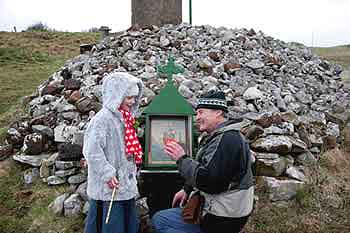 In times gone by the wells gave succour and consolation to the impoverished and the dispossessed. Masses were said in such places in Penal times when the price on the head of a priest was the same as that on a wolf. Although we respect the past and admire the people who survived in such difficult times we have no way to see into the future. Even in our wildest imaginings we cannot picture what this field, this countryside, will look like to the pilgrims who may walk here a hundred, or even fifteen hundred years from now. In times gone by the wells gave succour and consolation to the impoverished and the dispossessed. Masses were said in such places in Penal times when the price on the head of a priest was the same as that on a wolf. Although we respect the past and admire the people who survived in such difficult times we have no way to see into the future. Even in our wildest imaginings we cannot picture what this field, this countryside, will look like to the pilgrims who may walk here a hundred, or even fifteen hundred years from now.
Photo: Your web host chats with Ellen Kennedy
 Author’s Bio: Author’s Bio:
Joe Mc Gowan is a local historian and native of Mullaghmore, Co. Sligo. Born on the family farm, he worked there in his early years until emigrating to the U.S.A. in the early ‘60s. Six months after he arrived, he was drafted into the U. S. army. Following discharge from the Army, he lived and worked in the U.S. in commercial and residential construction for many years. Marrying, he returned to Ireland with his wife and young family in the late ‘70s. The ‘Celtic Tiger’ was not yet born, scarcity of work dictated a career change, so Joe took up salmon and lobster fishing off the Sligo coast aboard his half-decker fishing boat the ‘Connaught Ranger’ and conducting tour-boat trips to Inishmurray aboard the ‘Excalibur’ with his partner Keith Clarke.
Shortly after his return to Ireland, Joe McGowan, becoming keenly aware of the accelerating pace of change in the Irish countryside, decided to record the old lore before it vanished completely. Since that time he has been dedicated to preserving, visually and orally, Ireland’s disappearing traditions and customs. Now a full-time writer his books, backed by meticulous archival research, are inspired by countless nights spent visiting the older generation and listening to their tales. His short stories, usually cameos of Irish life both past and present, feature frequently in national magazines and on radio. He is also a Heritage Specialist with the Irish National Teachers Organisation ‘Heritage in Schools Scheme’.
His publications include the classic: In the Shadow of Benbulben; Echoes of a Savage Land; Constance Markievicz; the People’s Countess; Co. Sligo Famine Book; Inishmurray Gale, Stone and Fire; Island Voices and most recently, co-authored with artist Anne Osborne: Sligo, Land of Destiny.
The days of the fireside story-tellers are gone, but their stories and lore happily live on in Joe’s books and now on his website: Sligo heritage.
Related Link - The Holy Wells of ireland
|
|
Fri, Sep 27, 2024
 The Galway Hooker The Galway Hooker
This unique vessel, with its distinctive curved lines and bright red sails, originated in the village of Claddagh. During the 19th century, hookers supported a significant fishing industry and also carried goods, livestock and fuel. Seán Rainey is remembered for building the last of the original boats, the Truelight, for Martin Oliver who was to become the last king of the Claddagh; as king, he was entitled to white sails on his boat. Since the mid seventies, many of the old sailing craft which were on the verge of extinction have been lovingly restored and new ones have been built. During the summer months they can be seen at festivals such a Cruinniú na mBád - the Gathering of the Boats - in Kinvara.
Click for More Culture Corner.
This fascinating book was just released. Joe McGowan's easy familiarity with the folkways of his childhood helps transport us to these lost scenes of 1950s Ireland. We heard from Joe and he has a new Web Site. You can visit by clicking: Sligo Heritage.
Click here for Echoes
|
|




 The Galway Hooker
The Galway Hooker